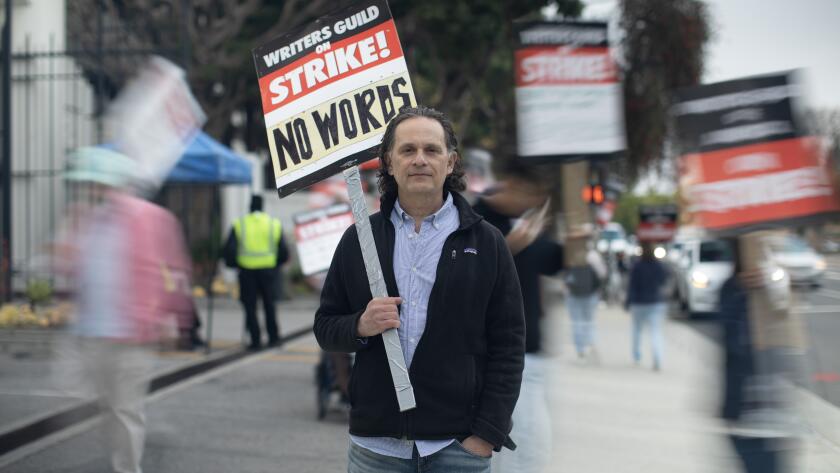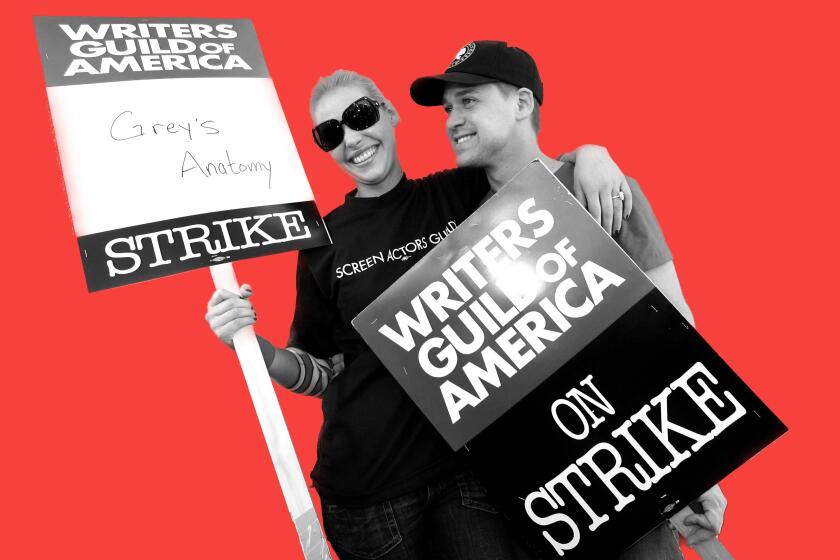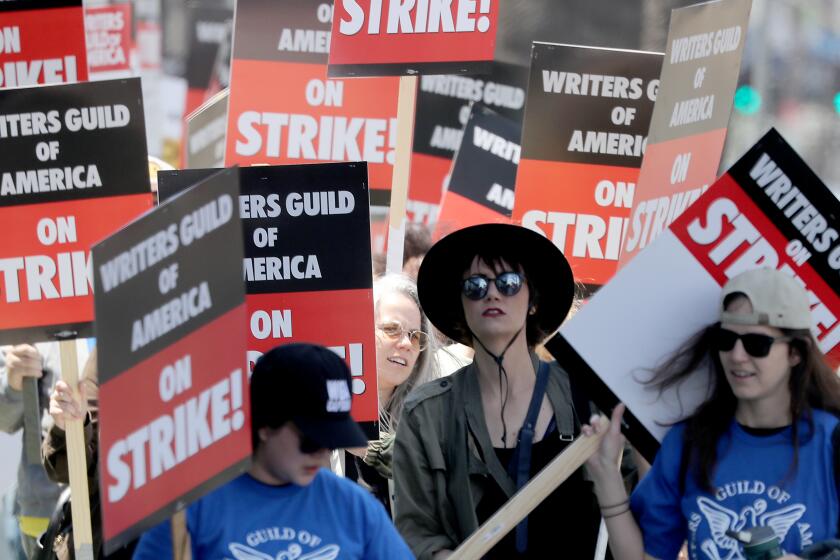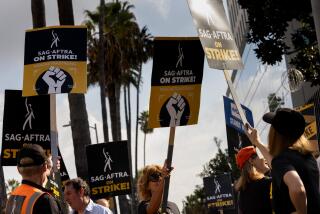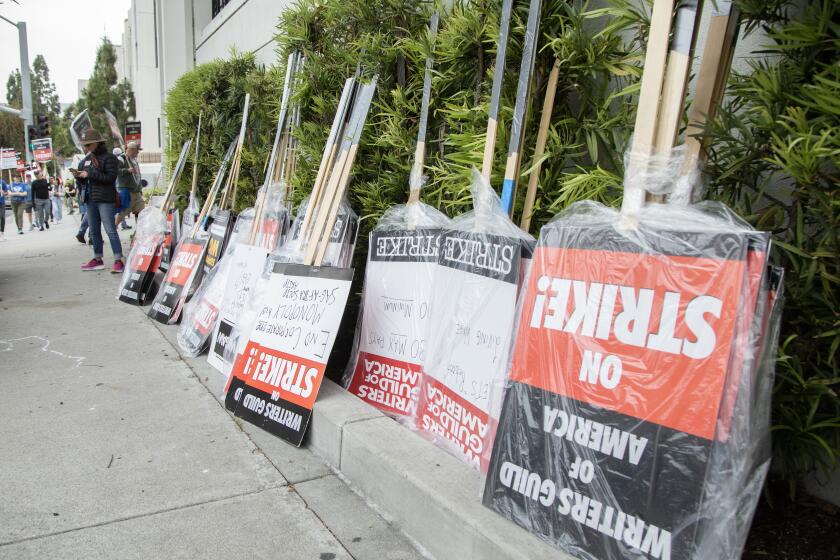Hollywood’s writers are on strike. Here are five things you need to know
Hollywood’s writers have gone on strike for the first time in 15 years amid a sea change in the way content is being distributed and creators are being compensated.
On Tuesday, 11,500 members of the Writers Guild of America went on strike. Since talks with Hollywood studios began March 20, the two sides have failed to reach an accord on a new three-year film TV contract to replace one that expired Monday.
A long strike could have a ripple effect on not only film and television production, but also the Southern California economy. The impact is also likely to be felt in Georgia, New York, New Mexico and other production hubs nationwide. Without writers, scripted television shows will struggle to continue filming and live late-night shows will stop immediately.
Here is a primer on what to know about the union’s first strike in 15 years.
Streaming has transformed television and led to a surge in content, but it also has squeezed Hollywood writers. Five Writers Guild of America members share their stories.
How did we get here?
The roots of the current labor conflict were planted during the previous writers strike in 2007-08, the first big clash over so-called new media. The rapid growth of Netflix and other online platforms since then has dramatically changed how entertainment is consumed, and how writers are paid for creating that entertainment.
Even as streaming content has boomed, however, writers argue that the new models have streadily eroded their pay and the ability to earn a living in Hollywood.
There were early signs of tensions.
WGA leaders have been signaling for some time that this bargaining cycle would be tough because, they say, so many guild members are working at minimum pay levels.
In an interview with The Times in 2021, WGA West President Meredith Stiehm described the situation as a financial emergency.
“It’s sort of like a turning point, the way it was in 2007 with the internet,” Stiehm said.
Less than a week before negotiations began with the Alliance of Motion Picture and Television Producers on March 20, WGA leaders warned of an “existential” threat to writers.
They presented to the studios a package of demands — from boosting minimum pay levels to higher streaming residuals — valued at nearly $600 million.
By early April, the WGA said the progress in talks was not sufficient, and it called for members to vote in favor of a strike authorization. The WGA strike authorization was granted by a historic margin — 98% to 2% — (among 9,218 ballots cast.)
Writers returned to the bargaining table on April 14. Still, by the midnight Pacific time deadline on May 1, there was no deal to be had.
Layoffs, hints of a recession and an uncertain future for streaming add up to contentious negotiations as the WGA looks for a new deal with Hollywood studios.
So what are the main sticking points for writers?
In short, writers argue that their pay hasn’t kept up with the rapid pace of technological change.
They say they are working for shorter periods of time and having to find several gigs a year to make ends meet. Typically, broadcast networks would order about 20 episodes for shows that would be worked on over 10 months. But in recent years, studios have more often focused on streaming short-order series with eight to 10 episodes.
In particular, writers have complained that residuals —the royalties they collect when the shows they create are re-aired — are much lower in the age of streaming than they were when they were working for broadcast networks, when successful shows would run for years in syndication.
Another sticking point is the growing use of mini-rooms, where small groups of writers lay out the foundation of a series before it goes into production and are often paid near minimum levels.
Half of series writers now earn scale (the minimum episodic or weekly rate) versus 33% during the 2013-14 season, according to a recent WGA survey. Median screenwriter pay hasn’t risen since 2018 and, adjusted for inflation, has fallen 14% in the last five years. And the median weekly pay for writer-producers declined 23% over the last decade when adjusting for inflation, the union said.
Although stunned by the medical leave of the union’s chief negotiator, many guild members have voiced confidence in his replacement, Ellen Stutzman.
What are the rules for writers during the strike?
The WGA released a long list of instructions to members last month about what work they can or cannot do. Film, TV, animation and fiction podcasts will be affected.
During a strike, a WGA member or their agent cannot meet with or negotiate with the studios and may not write or sell or option material, according to rules sent to members viewed by The Times.
Additionally, a writer can’t revise existing work, start a new project or deliver work to a struck company, whether they work from home or an office. Writers can’t even discuss work with studios, and they must save a digital date-stamped copy of all un-produced literary material within 24 hours of when the strike begins.
Even writer-producers or writer-directors are heavily limited in the work they can do during production and post-production as showrunners. For example, they can’t make cuts for time, make minor changes to dialogue or even change stage directions.
Although the WGA can’t stop members from doing purely production work, they are encouraging members not to do any such work in a show of support. During the 2007-08 strike, many showrunners refused to do any work for struck companies, according to the WGA.
The 2007-08 writers’ strike, and lingering mistrust between big media companies and their Hollywood workers, has cast a long shadow over current WGA contract talks.
Who is on strike?
So far, only the 11,500 members of the WGA are on strike, but that could change pending the outcome of other potentially contentious negotiations.
SAG-AFTRA and the Directors Guild of America have contracts that run through June 30, meaning their members cannot legally join in any job walkout until after the contracts expire.
However, the Teamsters have said they will not cross WGA picket lines. The 6,500 members of Local 399 include drivers and transport dispatchers, location managers and casting directors.
“Teamsters Local 399, as well as the rest of Teamster locals across the country, within the motion picture industry, are in full support of WGA’s fight,” Lindsay Dougherty, secretary general of Hollywood Teamsters Local 399, told The Times. “We will definitely be honoring the picket lines.”
SAG-AFTRA, the DGA and the International Alliance of Theatrical Stage Employees, which represents crews, also issued statements expressing strong support for the WGA, although the DGA told its members last month that under their current contract, employers could replace them if they choose not to work.
The solidarity stands in contrast to previous cycles of bargaining, when other guilds sometimes sparred with the WGA over strategy, and it may strengthen the writers’ leverage in negotiations.
The 2023 writers’ strike is over after the Writers Guild of America and the Alliance of Motion Picture and Television Producers reached a deal.
How long will this strike last?
No one knows, but history suggests it won’t be over quickly.
The longest WGA strike was in 1988 and lasted 153 days. The last WGA strike, in 2007-08, lasted 100 days.
The contract and terms that the two sides have to renegotiate — such as sorting through byzantine residual calculations across a range of work and distribution platforms — is complex and time-consuming.
Macro conditions do not point to a quick resolution. It’s not clear how willing studios will be to cut a deal at a time when many entertainment companies such as Walt Disney and Warner Bros. Discovery are being roiled by cutbacks and layoffs as Wall Street investors pressure them to increase the profitability of their streaming platforms.
Some studios may even view a walkout as an opportune time to scrap unprofitable writer deals through so-called force-majeure clauses in contracts.
A walkout could last weeks or months, depending on how negotiations play out with other Hollywood unions.
AMPTP has to start negotiations with the DGA on May 10, followed by SAG-AFTRA, which is scheduled to begin bargaining a month later.
More to Read
Inside the business of entertainment
The Wide Shot brings you news, analysis and insights on everything from streaming wars to production — and what it all means for the future.
You may occasionally receive promotional content from the Los Angeles Times.
